Your Ultimate Roof Calculator Guide: Accurately Estimate Your Roofing Needs
Roof budget:
Price
Flat Roof Services, Regular Price: $600
“Believe me, after all the roofs I’ve seen, I could probably calculate the cost of a new one in my sleep…but a calculator still helps for those tricky dormers!”
Denis Tchernov, main contractor ID Flat Roof

Download ID Flat Roof Calculator on Play Market and App Store
Play Market
App Store
Due to their modern appearance and ease of repair and installation, flat roofs have gained popularity in recent years. The average cost of replacing a flat roof is around $5-10 per square foot, and depending on the material, flat roof installation costs around $8,000 to $16,000.
Before the start of roofing work, any homeowner thinks about two main things:
- Which contractor should you hire for installation or repair work?
- How do you calculate flat roof work costs and decrease them?
Need to estimate roofing materials accurately and quickly? Enter the roof calculator. Our guide cuts straight to the chase, showing you exactly how to make precise material estimates for any roofing job using the roof calculator. Get ready for no-nonsense advice that will bring you from uncertainty to assurance without the fluff or sales talk.
Key Takeaways
- Precise roof calculations are vital for accurate material estimates and project costs, and the right tools, such as roofing calculators, simplify these estimations.
- Factors such as roof pitch, type, and architectural features significantly influence material needs, which can be estimated with roof measurements and calculators.
- Choosing the right roofing contractor involves verifying credentials, insurance, experience, and understanding written estimates and contracts for a successful roofing project.
Understanding Roof Calculations
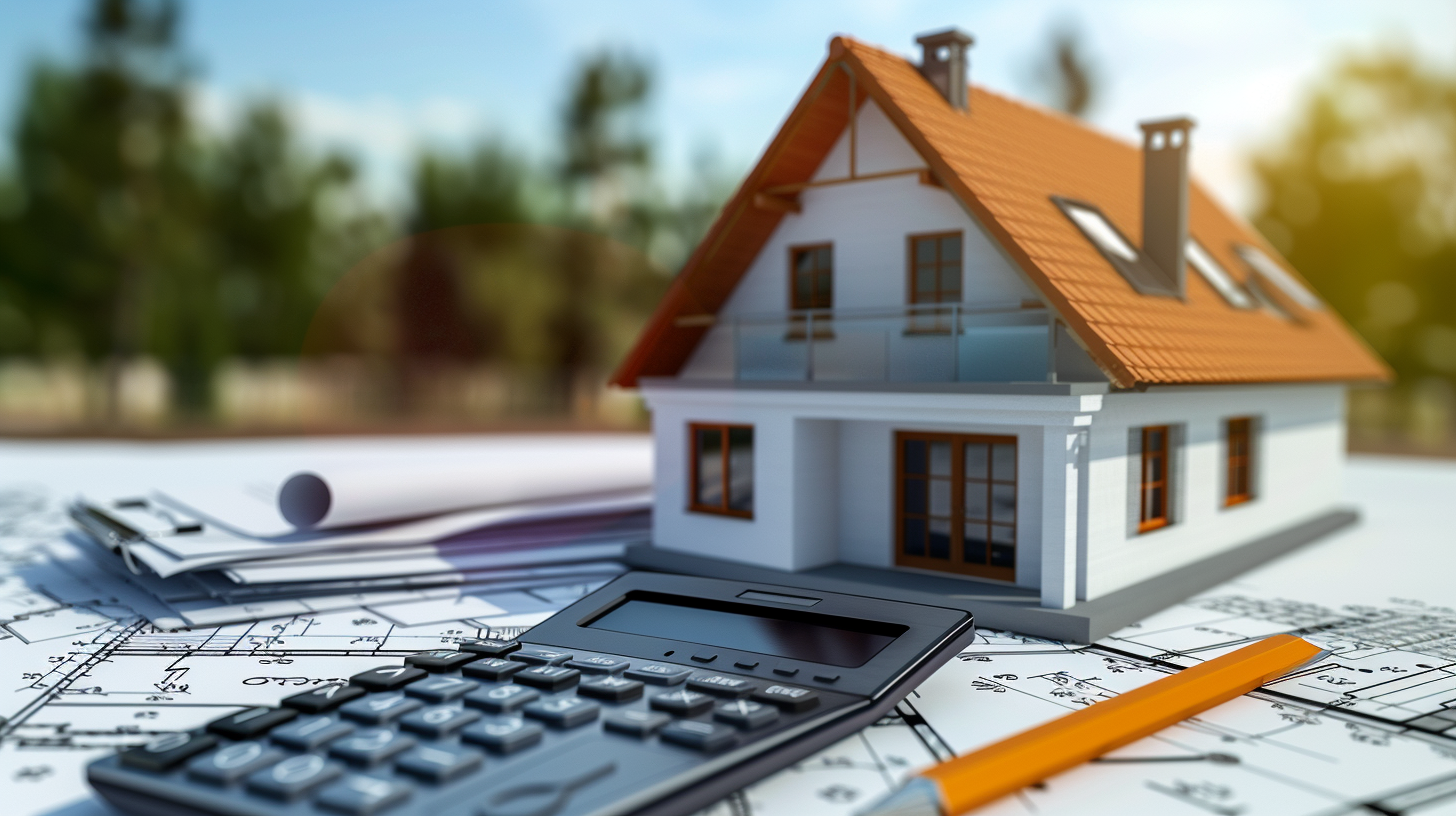
Accurate roof calculations are integral to the planning and execution stages of roofing projects. They directly influence the quantity of roofing materials required and the project’s overall cost. Roofing contractors rely heavily on precise calculations, significantly impacting project quotes and their reputation and bottom line. On the other hand, homeowners need exact roofing estimates to allocate funds accordingly, underscoring the fundamental role of correct roof measurements and calculations.
Accurate roof calculations can seem elusive due to many factors to consider. Each element plays a vital role in the calculation, from the roof’s pitch to its shape and size. In this pursuit, tools like a roofing calculator and a roofing material calculator can be invaluable allies, making the process more manageable and precise. By the end of this guide, you’ll understand how to calculate standard roof pitches and estimate and find the total amount of roofing materials needed for any roofing project efficiently.
To understand exactly how the flat roof calculator works, you need to find out precisely what it calculates and what factors can affect the cost of installation services.
We have compiled the most complete list of any flat roof estimate components.
- Let’s start with measurements. Before the roof installation, the roofers must visit the site, accurately measure the rooftop, clarify its features, and provide the required list of installation elements. For example, the installation cost will increase if a drainage system is necessary.
- Further, responsible contractors prepare an installation project before installation, where they describe in detail the materials, technologies, hours of operation, main stages of the process, etc.
- After that, the project is agreed upon with you as a client. At the same stage, the necessary materials are selected because when calculating in a flat roof material calculator, the total amount may differ due to the type of roofing materials and fasteners, and sometimes, this difference can be very significant.
- Then, the contractor calculates the direct work cost of specialists. It can be hourly, footage-based, or a combination of the two. It all depends on the contractor and their working conditions.
If you calculate all this manually or rely on the contractor’s calculations, there can be many inaccuracies. Human error, the ability to fool a client, or just chance can make your roof estimate incredibly inflated. That’s why a flat roof price calculator can be a godsend for avoiding unnecessary expenses.
Just remember the costs for delivery of roofing materials. So, the price is calculated on three main factors:
- Material costs.
- Contractor rates.
- Delivery costs.
You should also add to them the price for your old roofing removal if it is needed.
Roof Pitch and Its Impact on Calculations
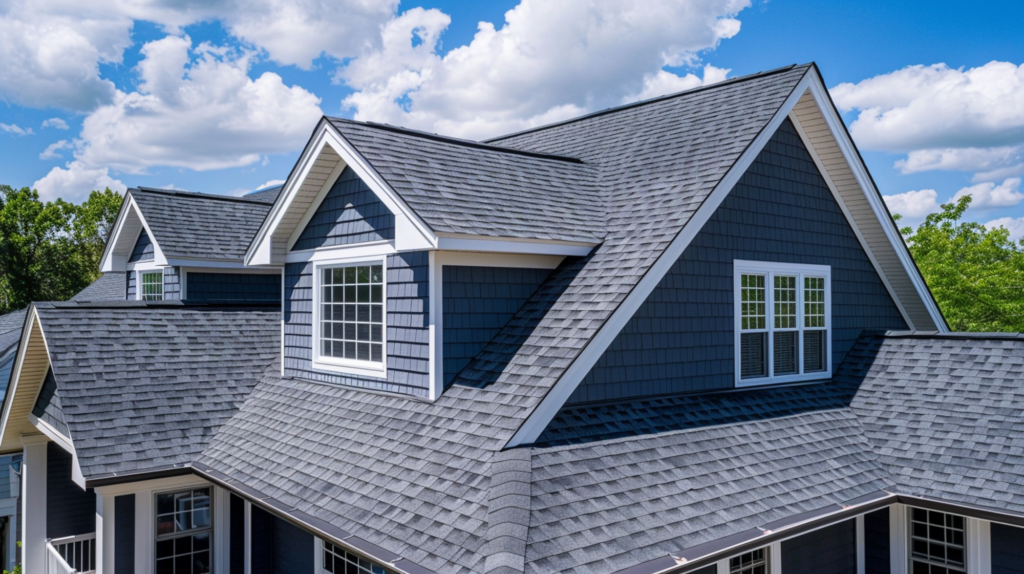
The roof’s edge pitch or slope is one vital factor impacting the roofing material required. But what exactly is a roof pitch? It refers to the angle or slope of a roof, usually expressed as a ratio of the roof’s rise to the horizontal distance. This slope is determined by calculating the vertical rise over a 12-inch horizontal span, which can be obtained using a pitch gauge or manual calculations.
Interestingly, the slope of the roof deck alters the amount of materials required. Why is that? Well, steeper roofs necessitate more materials due to having a larger actual surface area than it appears from a bird’ s-eye view. Standard slope correction factors are applied to accommodate the extra material for pitched roofs. This is done by multiplying the horizontal area by the corresponding correction factor derived from a roof pitch multiplier chart. It’s pretty fascinating.
Types of Roofs in MA and Their Measurements
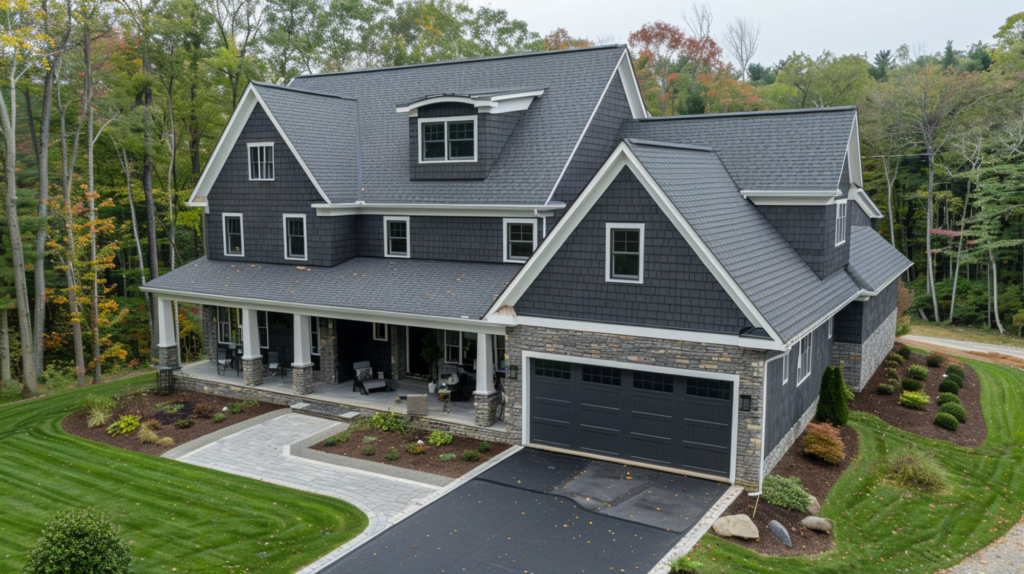
Roofs come in many shapes and sizes. Among the most common architectural roof types are:
- Gable roof, which is highly popular and has a range of slopes possible
- Shed roof, which has a single slope and is often used for smaller structures
- Flat roofs, which are horizontal and commonly found on commercial buildings, are an excellent choice for those seeking a minimalist design.
- Hip roofs, which have slopes on all four sides and are more stable in high winds
- Mansard roofs, which have two slopes on each side and provide extra living space in the attic
- Gambrel roofs, which have two slopes on each side and are commonly seen on barns and farmhouses
- Butterfly roofs have two slopes that slope inward and are often used for modern, eco-friendly designs.
Each roof type has unique design features important for roofing material selection.
Calculating the roof area of each type requires understanding its specific measurements, which differ between gable, flat, and shed roofs.
This is where the ability to calculate the length and width of each roof section comes in handy. Multiplying these two figures to determine the overall roof area might seem daunting, but it’s more straightforward with the proper knowledge and tools.
Flat Roof Repair Cost: What to Consider
What do you say about another issue that makes you apply for roofing contractors’ services? We mean urgent or planned flat roof repair. There are pretty much the same expenditure items to consider. Besides, when you use a flat roof replacement cost calculator, remember to schedule the visit of contractors to investigate the current roof condition and plan the replacement or repair.

You should also insert the total area of work in a flat roof cost estimator to calculate it correctly. There are significant pricing gaps between repairing a ten-square-foot area on your roof and replacing a total roofing area of 100+ square feet.
Using a Roofing Calculator

Now that we’ve unpacked the importance of roof measurements and the impact of the roof’s slope and type on these calculations, let’s delve into a tool that can simplify this process immensely—the roofing calculator. This handy device estimates roof size and calculates required materials and costs, enhancing measurement accuracy. To use it, you must input three key measurements: the roof’s width, length, and slope into the correct fields.
Selecting the roof pitch is critical for area calculations, as this impacts the number of individual shingles and how many bundles are required.
A roofing area calculator can provide these values, helping you turn raw measurements into actionable data and better understand your roofing project’s scope and requirements. It’s quite a game-changer, wouldn’t you agree?
Inputting Roof Dimensions
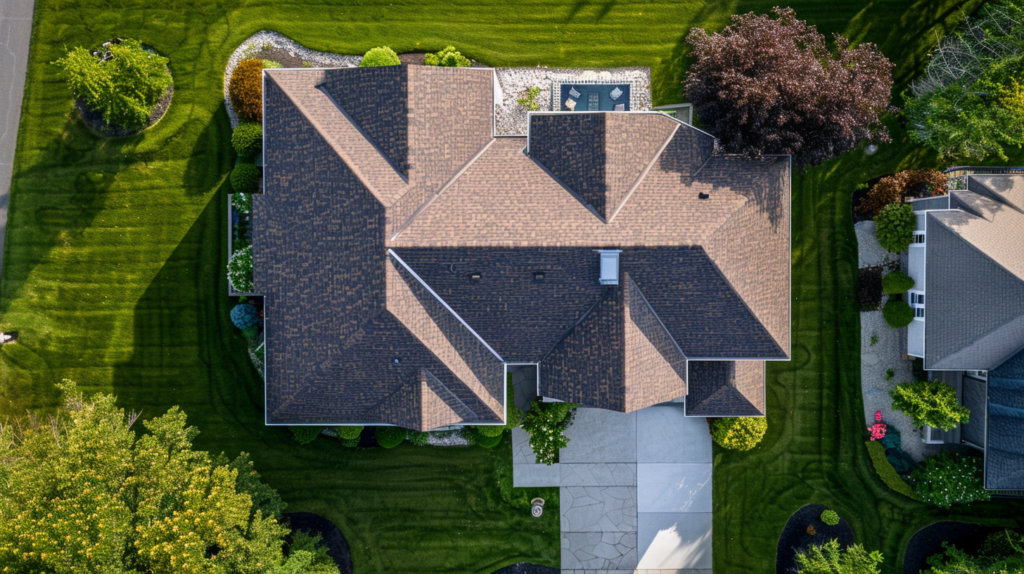
When using a roofing calculator, the first step is to determine how many squares is the surface area of the roof’s footprint. To do this task, you need to:
- Measure the length and width of each roof section.
- Multiply the two figures to find the area.
- For complex roof shapes, measure the dimensions and areas of each part of the roof shape, using the aggregate area of these simple shapes for a more accurate estimation.
When it comes to flat roofs, the process is slightly more straightforward. You can directly input the length and width into the flat roof-ing calculator without accounting for slopes or angles. This approach simplifies the calculation process, making it more accessible for everyone, regardless of their flat roof-ing knowledge or experience.
Selecting Roofing Materials

Once you have an accurate measure of your roof’s square footage, it’s time to estimate the roofing materials needed. This includes shingles, underlayment, and other materials necessary for your project. Roofing materials are measured in ‘squares,’ which equate to 100 square feet of area. You’ll divide the total square footage by 100 to determine the number of squares required.
Regarding the number of shingles per square, you’ll need to plan to use three bundles per square. You’ll multiply the squares by three to determine how many bundles of shingles are needed. For underlayment, the calculation is based on the number of squares, considering that rolls of underlayment typically cover four squares each. By understanding these calculations, you will be well-equipped to estimate the total material required for your roofing project.
Reviewing and Interpreting Results

Now that you’ve inputted all the necessary information into the roofing calculator, it’s time to review and interpret the results. The calculator assists in determining the total number of shingles required for a project, factoring in a 10% overage and the total number of squares and bundles. For instance, for a roof measuring 2,240 square feet, the calculator estimates the need for an average bundle of approximately seven rolls of #30 felt underlayment.
It’s important to note that while the calculator provides a detailed breakdown of material needs, it should not replace a comprehensive project quote from a contractor. An itemized roofing estimate should encompass all costs, such as:
- labor
- materials
- permits
- debris cleanup
This level of detail is typically reviewed when considering the overall project cost rather than the calculator’s immediate output.
Understanding these distinctions allows you to effectively leverage the roofing calculator to plan and execute your project.
What Things Are Crucial to Consider for a Flat Roofing Budget
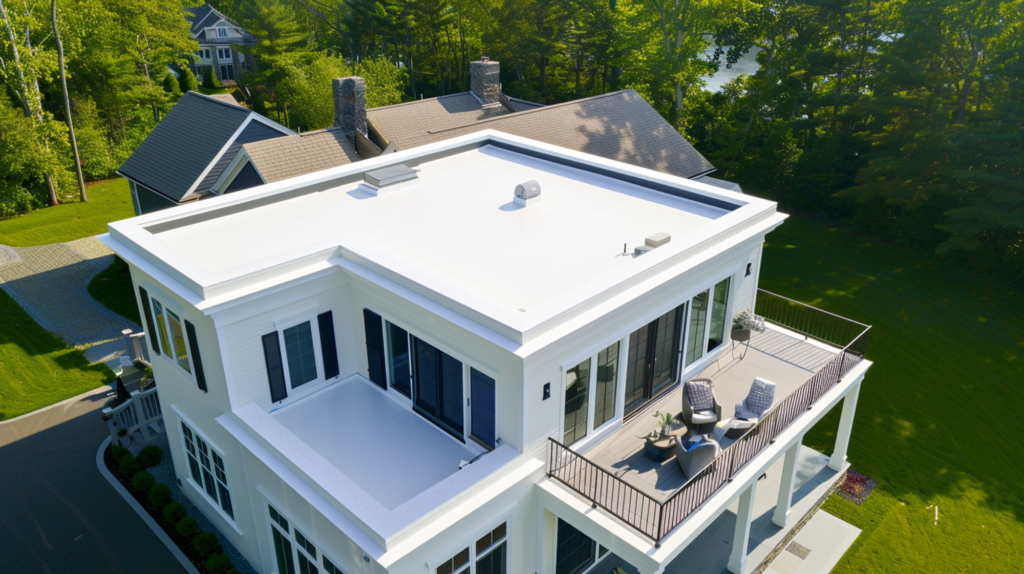
The type of roofing material is the first thing that impacts the price of a household or commercial roofing calculator. Look at the price list of any roofing material supplier to see that ceramic tiles are more costly than metal roofing. A PVC membrane roof is more profitable to install if you choose a rubber roof estimate calculator to get a quote.
On average, several things are crucial for calculating the roofing price.
- Is it private property, or do you use a commercial roof replacement cost calculator? The price can be higher for commercial properties.
- Is it a total replacement or just a tiny repair that you need?
- How urgent is the work?
- What materials and extra spare parts does a contractor use in the process?
- How far is the place where the contractor will visit? You might have to pay riding expenses for a visit within the boundaries of a company’s working area.
Fortunately, you can easily calculate the cost of any roofing work on our website today. Whether you want a quote from a rubber roof cost estimator or a PVC membrane roof installation quote, our automated online calculator service will do the job. You’ll get the information in a few steps.
- Please enter your address so we can calculate an estimated cost for our technicians to visit and ship materials for your roof repair or installation.
- Choose your roof type.
- Also, indicate the pitch type of your roof.
Then our calculator will do everything for you. You will receive an approximate calculation of the materials you need to install or upgrade the roof. Of course, we can correct the data obtained in such a calculator because ID Flat Roof always works for the benefit of customers and adapts its services to each budget. So, with our calculator’s help, you can navigate the approximate roof cost after you consult with our experts. Their competent opinion will allow you to choose an inexpensive and effective solution for your flat roof.
Tips for Accurate Roof Measurements
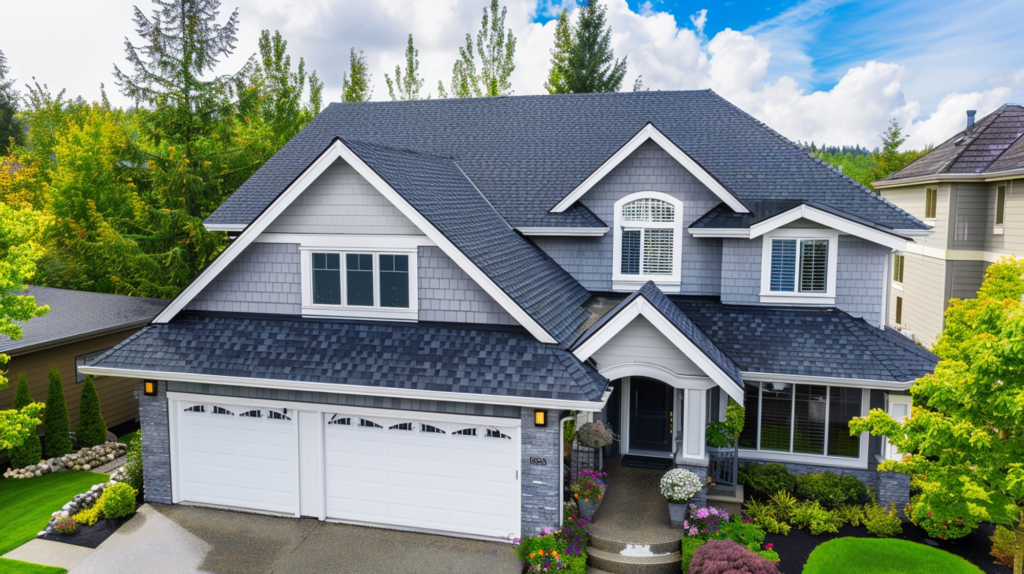
Accurate roof measurements are crucial to order the correct amount of materials. This includes measuring every section and plane of the roof, including protrusions and overhangs, to calculate the exact square footage. Moreover, double-checking all measurements can minimize the potential for errors or miscalculations. Even with the use of advanced technology like CAD for measurements, it’s still recommended to verify the measurements manually to ensure accuracy to the inch.
While seemingly straightforward, these tips can significantly improve the success of your roofing project. Accurate measurements reduce the risk of costly mistakes or delays, ensuring your project stays on track and within budget. After all, an ounce of prevention is worth a pound of cure, right?
Measuring Complex Roofs
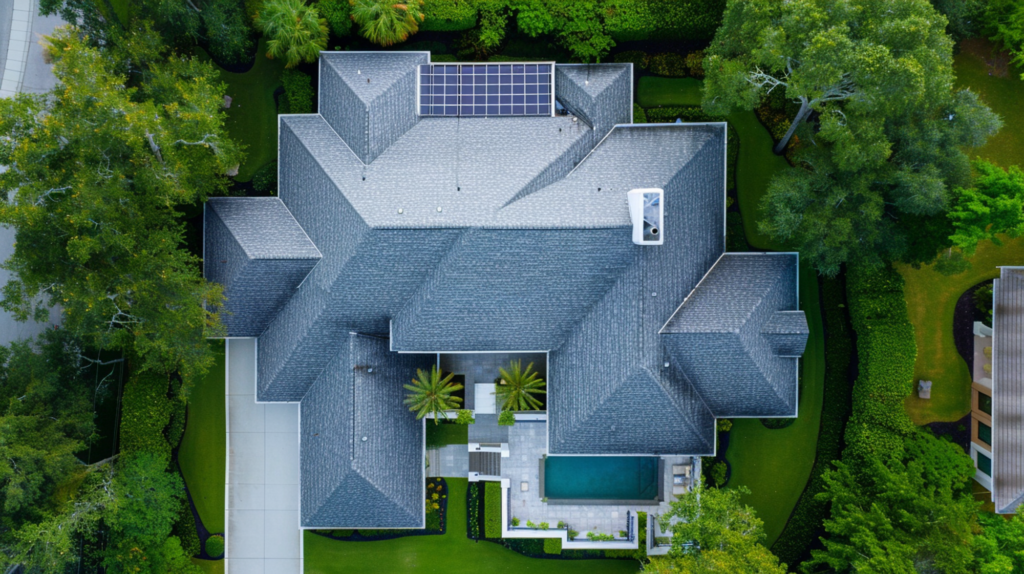
Regarding complex roofs, accurate measurements can be a bit trickier. The first step is to take the length and width of the actual area of each roof surface, including additional elements like dormers, noting the presence of chimneys, skylights, or other obstructions. To make the process easier, create a detailed sketch of the actual area of the roof, write down all measurements, and use simple geometric formulas for triangular areas.
Additionally, when measuring the total area of a complex roof, consider the dimensions of distinct architectural features such as:
- dormers
- skylights
- overhangs
- peculiar aspects of the roof that may affect material needs
Finally, the total square footage of the complex of roof area is calculated by summing the square footage of each surface area together. At the same time, it might seem daunting, but using a roof square footage calculator can make measuring complex roofs a breeze.
Accounting for Architectural Features
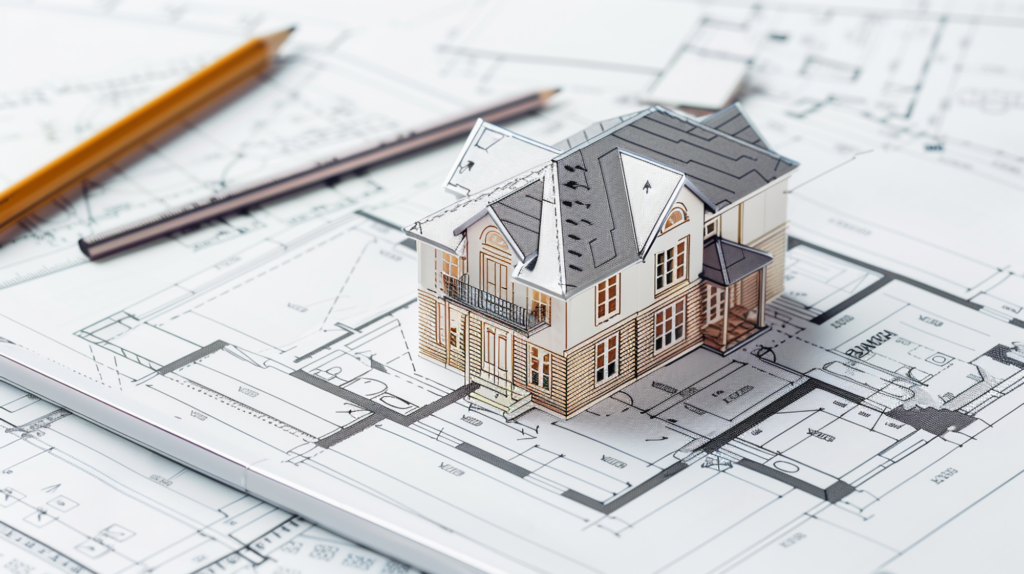
Architectural features on many roofs, such as chimneys, skylights, dormers, hips, and valleys, significantly influence a roof’s surface area and material requirements. It’s, therefore, crucial to measure the length and width of each of these elements and include these in the total calculation of material needs.
I remember the first time I tried to measure a roof’s surface area with many architectural features. I was so focused on getting the measurements right that I forgot to account for the chimney. As a result, I ended up with a lot of extra material that I had to pay for. But I learned my lesson, and now I always factor in all architectural features when measuring a roof. And I always keep a sense of humor because no one wants to be stuck with a roof that’s too small or too big!
Simplifying the Measurement Process
To simplify the process, you can create a detailed sketch of the total roof area and divide it into manageable sections such as squares, rectangles, or triangles for a more straightforward calculation.
Measuring Additional Features
Additionally, architectural additions such as gables, dormers, or valleys should be measured separately using geometric simplification where necessary, and their areas should be added to the primary roof sections’ total surface area.
Don’t Forget Ridges and Valleys
Lastly, it is crucial to include the ridge line and valleys in your measurements. This accounts for the overlap needed for valley trim, which affects the final material quantities. With these tips in mind, you’ll be well-equipped to accurately account for all architectural features in your roofing project.
Ensuring Safety While Measuring
Safety should always be the top priority when measuring a new roof here. This involves:
- Maintaining a clean and organized work area
- Cordoning off the area to prevent accidents
- Identifying potential hazards like power lines and unstable access points
- Extra caution is advised in extreme weather conditions such as rain or extreme heat to avoid falls and weather-related hazards.
- Measures to combat heat-related health risks should also be in place, such as providing a shaded area for breaks and ensuring that water is consumed regularly.
Appropriate protective gear, including footwear, headgear, and clothing, should be worn to shield from UV rays and reduce injury risks. Furthermore, a complete personal fall arrest system, comprising a harness, lanyard, rope grab, rope, and roof anchor, is essential for safe roof measurement. The system is selected based on specific job-site conditions and building height.
Lastly, adherence to safety protocols for ladder use is paramount. These include engaging all locks on extension ladders and positioning the ladder’s base one-quarter of its working length from the wall. Remember, safety comes first!
Comparing Roofing Material Options
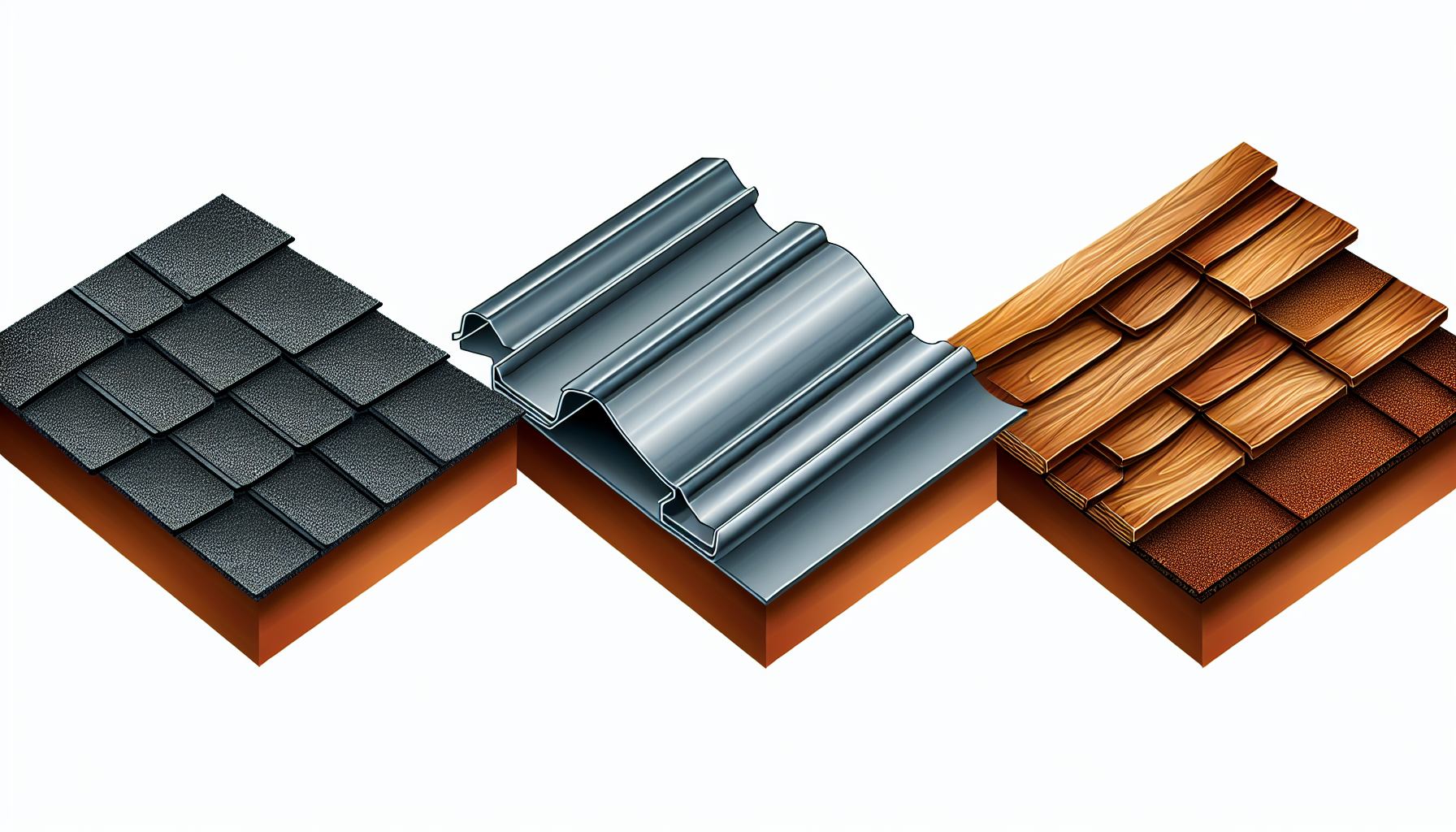
As you delve into your roofing project, you’ll soon realize that there is a wide array of roofing materials to choose from, each with its pros and cons. The options are vast, from cost-effective asphalt shingles to durable metal roofing and aesthetically pleasing wooden shingles. This variety, while beneficial, can make the decision process overwhelming. But fear not! In the following sections, we’ll compare these materials, discussing their pros and cons to help you make an informed decision.
The best roofing material for your project depends on several factors, including your budget, the local climate, and the aesthetic you wish to achieve. While the initial purchase and installation costs are crucial, homeowners should also account for long-term expenses such as maintenance or replacement when assessing the overall affordability of roofing materials. By understanding the benefits and drawbacks of each material, you’ll be able to choose the one that best suits your needs.
Asphalt Shingles

Asphalt shingles, also known as roof shingles, are among the most popular roofing materials due to their affordability and easy installation. They come in various styles, including laminated, three-tab, and premium versions, allowing you to choose a style that best matches your home’s aesthetic. However, they do come with their set of drawbacks. While they are easy to install, asphalt roof shingles have durability issues and a shorter lifespan than other materials.
Furthermore, here are some essential points to consider when installing asphalt shingles:
- Installing in temperatures below freezing can lead to damage during the installation process.
- On the bright side, replacing damaged asphalt shingles is straightforward since they can be replaced individually without replacing the entire roof.
- Regarding material estimation, three bundles of asphalt shingles typically cover 100 square feet, which helps calculate the number of bundles needed for a roofing project.
Asphalt shingles are a versatile and cost-effective solution for many homeowners.
Metal Roofing
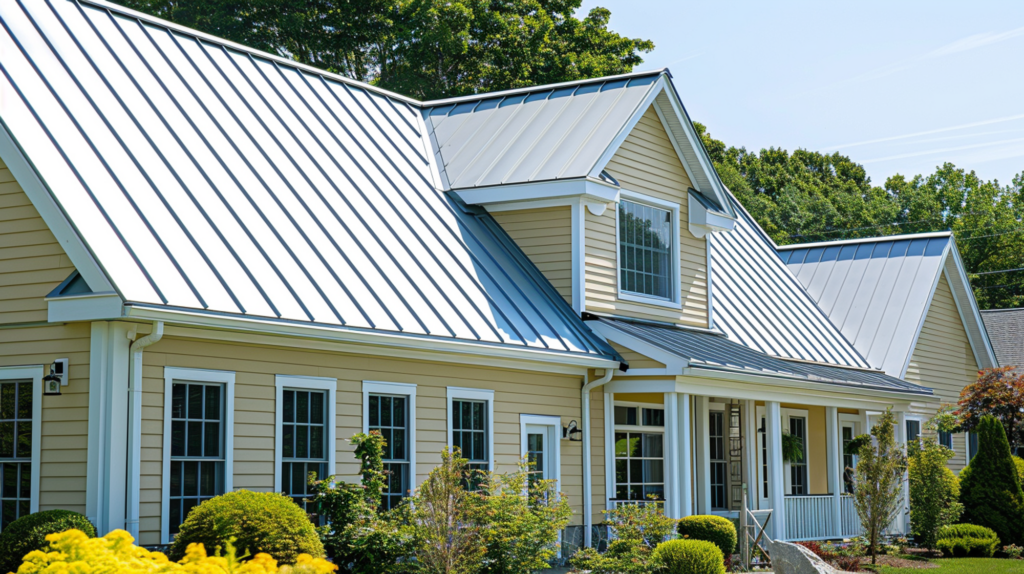
On the other end of the spectrum, you have metal roofing. Renowned for its durability and energy efficiency, metal roofing lasts 40 to 70 years. What’s more, metal roofs are not only more sustainable than traditional roofing materials, but they also contribute to energy savings by reflecting solar heat and providing better insulation.
However, it’s worth noting that metal roofing has a higher initial cost and potential noise issues during rain or hail events. Some considerations with metal roofing include its susceptibility to denting and the risk of corrosion in certain metals when installed in coastal climates and high-wind areas. Despite these drawbacks, the longer lifespan and energy efficiency of metal roofing can offset its higher upfront cost over time, making it a worthwhile investment for many homeowners.
Wooden Shingles
Last but not least, let’s discuss wooden shingles. These cedar, spruce, redwood, or treated pine shingles provide a distinct aesthetic appeal that stands out from standard asphalt shingles. In addition to their visual benefits, wooden shingles offer excellent insulation, contributing to energy savings by keeping homes more relaxed in the summer and warmer in the winter.
Despite these benefits, wooden shingles come with their own set of challenges. They require regular maintenance to prevent degradation from elements like moisture or pests and are at higher risk for fire damage.
However, with the proper maintenance and care, wooden shingles can be a beautiful and functional addition to any home.
Working with Roofing Contractors

Now that you know about roof calculations, material estimation, and various roofing materials, it’s time to turn to the professionals. Choosing a qualified roofing contractor is crucial for the success of your roofing project. A good roofing contractor can provide accurate project quotes, perform high-quality installation, and offer valuable advice based on their expertise.
However, finding the right contractor can be a daunting task. It requires:
- Verifying their validity
- Checking for adequate insurance coverage
- Considering their experience
- Opting for local contractors when possible for familiarity with regional specifics
- Inspecting a contractor’s contract for detailed information about the project scope, responsibilities of each party, pricing, and timelines to avoid future misunderstandings.
Rest assured, one bundle of the following sections will guide you through this process, ensuring you pick the right contractor for your roofing project.
Choosing the Right Contractor
When choosing a roofing contractor, the first step is to verify that they hold proper licensure, display critical certificates, and have the necessary insurance, including workers’ compensation and liability insurance. You should also check for contractor certifications from well-known roofing manufacturers such as GAF, CertainTeed, and Owens Corning, as these may offer extended warranties and training on specific products.
In addition to verifying the contractor’s qualifications, it’s also helpful to:
- Seek recommendations from friends and neighbors
- Research local reputable roofing companies online to gauge their community standing
- Read online reviews and testimonials, and analyze the contractor’s Better Business Bureau rating and industry recognition.
This can provide a comprehensive view of their reputation.
By going through these steps, you can ensure that you choose a competent and reliable contractor for your roofing project.
Communicating Your Needs
Once you’ve chosen a contractor, clear communication is critical to ensuring a successful roofing project. Provide the contractor with reliable contact methods, such as phone, email, or text, to ensure fluid communication. Discuss your availability with the contractor to prevent communication gaps and unapproved decisions.
Setting up a communication plan detailing how and when you will receive project updates is also crucial. Ensure that the materials listed in the estimate are clearly described, possibly with images, to clarify what is being installed. Stay involved by observing the materials used and the work done on the roof to maintain an informed dialogue with your contractor.
Of course, don’t hesitate to promptly communicate any concerns that arise so we can address them.
Reviewing Estimates and Contracts

Before signing any contracts, ensure all project details are in writing within the estimate, including overall costs, completion dates, materials used, insurance, and contractor licensing. To prevent liabilities and disputes, the roofing contract should include payment terms, change order provisions, lien release, and a termination clause.
Understanding Cost Breakdowns

Understand the cost components, including labor, determined by work complexity and skill level, material costs based on quality, overhead expenses, and the company’s profit margin.
Contingencies and Scope of Work
The estimate should account for potential additional costs, such as permit fees or disposal costs for old roofing materials. The estimate’s scope of work should outline yard protection, tear-off, installation, cleanup, and warranty information while detailing payment methods, including deposits and fees.
Comparing Multiple Contractors
Comparing estimates from several contractors allows for competitive pricing and service range while reviewing policies on unforeseen repairs and overages.
Timeline and Expectations
Lastly, ensure the estimate includes completion timeframes and details regarding compensation or recourse for significant delays.
Summary
In conclusion, accurate roof calculations, the right choice of roofing materials, and working with qualified contractors are key to a successful roofing project. While it may seem daunting at first, armed with the right knowledge and tools, you can easily navigate the complexities of roof calculations, roofing material calculator, and estimation. So go ahead, take the plunge, and start your roofing project with confidence!
Frequently Asked Questions
To calculate the square footage of your roof, multiply your house length by your house width to get the full area of your roof, and then multiply the area by your roof’s pitch. For example, 40 feet x 30 feet = 1,200 square feet, then 1,200 x 1.05 = 1,260 square feet.
For a 2,000-square-foot house, you will need approximately 3,000 square feet of shingle roofing, which equates to 20 shingle roofing squares or 60 bundles of shingle material.
To calculate the roof cost, first calculate the area, determine the area of the roof, and then find the unit price of roofing (per square meter or square foot). Multiply the location of the roof area and the unit price to obtain the estimated roofing cost. For example, a simple roof with asphalt shingles may cost between $4 to $6 per square foot, resulting in a total cost between $6,000 and $9,000 for a 1,500-square-foot roof. For a more complex roof with standing seam metal, the cost could range from $12 to $19 per square foot.
Roof pitch impacts the required materials, with steeper roofs needing more materials due to a larger surface area. This means the cost of materials will be higher for a steeper roof.
A roofing calculator estimates roof size calculates roof materials and costs and improves measurement accuracy. This helps in planning and budgeting for roof projects.



